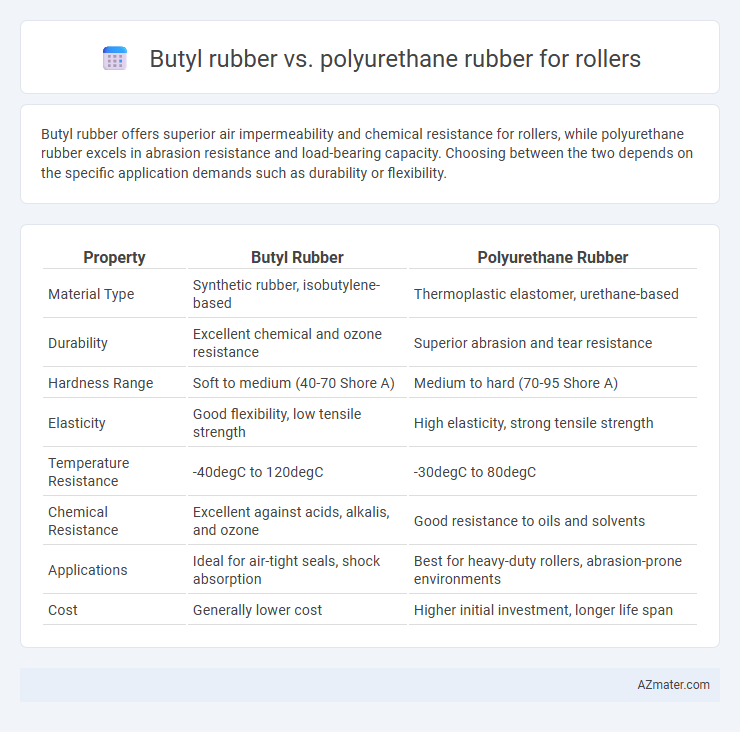Butyl rubber offers superior air impermeability and chemical resistance for rollers, while polyurethane rubber excels in abrasion resistance and load-bearing capacity. Choosing between the two depends on the specific application demands such as durability or flexibility.
Table of Comparison
| Property | Butyl Rubber | Polyurethane Rubber |
|---|---|---|
| Material Type | Synthetic rubber, isobutylene-based | Thermoplastic elastomer, urethane-based |
| Durability | Excellent chemical and ozone resistance | Superior abrasion and tear resistance |
| Hardness Range | Soft to medium (40-70 Shore A) | Medium to hard (70-95 Shore A) |
| Elasticity | Good flexibility, low tensile strength | High elasticity, strong tensile strength |
| Temperature Resistance | -40degC to 120degC | -30degC to 80degC |
| Chemical Resistance | Excellent against acids, alkalis, and ozone | Good resistance to oils and solvents |
| Applications | Ideal for air-tight seals, shock absorption | Best for heavy-duty rollers, abrasion-prone environments |
| Cost | Generally lower cost | Higher initial investment, longer life span |
Introduction to Roller Materials
Butyl rubber and polyurethane rubber are two prominent materials used in roller manufacturing, each offering distinct performance characteristics. Butyl rubber is known for its excellent air impermeability, chemical resistance, and flexibility, making it suitable for rollers in environments requiring airtight seals and moderate wear resistance. Polyurethane rubber excels in abrasion resistance, load-bearing capacity, and durability, making it ideal for high-impact roller applications with heavy loads and continuous operation.
Overview of Butyl Rubber Properties
Butyl rubber offers exceptional impermeability to gases and excellent resistance to heat, ozone, and weathering, making it ideal for roller applications requiring airtight seals and durability in harsh environments. Its low permeability and good flex resistance ensure long-lasting performance under repetitive motion and stress. Compared to polyurethane rubber, butyl exhibits superior chemical stability but lower abrasion resistance, influencing material selection based on specific roller operational demands.
Overview of Polyurethane Rubber Properties
Polyurethane rubber offers superior abrasion resistance, high tensile strength, and excellent flexibility compared to butyl rubber, making it ideal for roller applications requiring durability and load-bearing capacity. Its resistance to oils, solvents, and environmental factors enhances performance in industrial settings where butyl rubber may degrade. The elastomer's ability to maintain shape under stress and resist tearing supports longer roller lifespan and consistent operational efficiency.
Durability Comparison: Butyl vs Polyurethane
Polyurethane rubber offers superior abrasion resistance and tensile strength compared to butyl rubber, making it more durable for roller applications subjected to heavy wear and mechanical stress. Butyl rubber excels in chemical resistance and elasticity but tends to degrade faster under continuous friction and load. For rollers requiring long service life in harsh operational environments, polyurethane provides enhanced durability and reduced maintenance intervals.
Chemical Resistance: Which Rubber Performs Better?
Butyl rubber exhibits superior chemical resistance, especially against acids, alkalis, and polar solvents, making it ideal for rollers exposed to harsh chemical environments. Polyurethane rubber offers excellent resistance to oils, fuels, and abrasion but tends to degrade more rapidly when in contact with strong acids or bases. For rollers requiring maximum chemical durability in aggressive media, butyl rubber outperforms polyurethane rubber in longevity and stability.
Abrasion and Wear Resistance in Rollers
Polyurethane rubber exhibits superior abrasion and wear resistance compared to butyl rubber, making it ideal for rollers subjected to high friction and mechanical stress. Butyl rubber offers excellent chemical resistance and flexibility but tends to wear faster under abrasive conditions. For industrial rollers requiring long service life and durability in abrasive environments, polyurethane rubber is the preferred choice.
Temperature Tolerance Differences
Butyl rubber exhibits superior resistance to extreme temperatures, maintaining flexibility and performance between -40degC and 120degC, making it ideal for low to moderate thermal environments in rollers. Polyurethane rubber offers a broader temperature tolerance, functioning effectively from -40degC up to 150degC, which enhances durability and wear resistance in applications involving higher heat exposure. Selecting polyurethane rubber for rollers ensures enhanced thermal stability and extended service life under elevated temperature conditions compared to butyl rubber.
Cost Analysis: Butyl Rubber vs Polyurethane
Butyl rubber offers a lower initial cost compared to polyurethane rubber, making it a budget-friendly option for roller applications with less demanding performance requirements. Polyurethane rubber, despite its higher upfront price, provides superior durability, abrasion resistance, and longer lifespan, which translates to lower maintenance and replacement costs over time. Cost analysis reveals that while butyl rubber reduces short-term expenses, polyurethane's cost efficiency emerges in long-term operational savings and enhanced roller performance.
Application Suitability for Industrial Rollers
Butyl rubber offers excellent impermeability and chemical resistance, making it ideal for industrial rollers exposed to harsh chemicals and airtight environments, such as in pharmaceutical or food processing industries. Polyurethane rubber excels in abrasion resistance and load-bearing capacity, proving suitable for heavy-duty rollers used in printing, paper manufacturing, and conveyor systems where durability and mechanical strength are paramount. Selecting between butyl and polyurethane depends on specific industrial demands, with butyl favored for chemical resistance and polyurethane for wear resistance and mechanical performance.
Conclusion: Choosing the Right Rubber for Your Roller
Butyl rubber offers excellent chemical resistance and airtight properties, making it ideal for rollers used in harsh environments or requiring low permeability. Polyurethane rubber provides superior abrasion resistance and load-bearing capacity, suitable for heavy-duty applications with frequent mechanical stress. Selecting the right rubber depends on the operational conditions, prioritizing butyl for chemical exposure and polyurethane for durability under physical wear.

Infographic: Butyl rubber vs Polyurethane rubber for Roller
 azmater.com
azmater.com